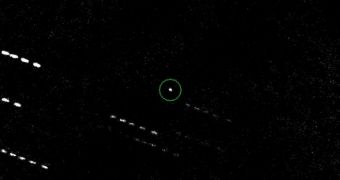Scientists are currently keeping a close eye on a dangerous space rock, that has a small chance of slamming into our planet in 2029, and then again in 2036 and 2068. Recently, astronomers managed to take the first picture of the object in more than three years.
According to calculations, the asteroid Apophis has a 1-in-250,000 chance of impacting our planet in 2029. This is a lot lower than the 1-in-37 chance in had when it flew close by in 2004.
This is when the rock became famous, and experts started taking an interest in it. The event also highlighted the need for space monitoring, as well as for the creation of an advanced early warning system covering the entire globe.
Apophis, named after Apep, the Egyptian god of darkness and chaos, has a diameter of 900 feet (270 meters), and is capable of putting a serious dent in our planet, our civilization, and even our species, if it strikes Earth.
Given this threat, specialists have been monitoring it closely since 2004, but they failed to take any pictures of it since three years ago. But this cycle was broken on January 31, when Apophis was imaged as it was coming out from behind the Sun.
Scientists used telescopes atop Mauna Kea to conduct the investigations. They were able to catch the asteroid flying to the outer solar system, and further refine calculations about its trajectory.
This is very important, since the April 13, 2029 pass it will make by our planet will bring it closer to the surface than most communications satellites are today. Any minute change in its orbit, and the rock could either hit us, or move thousands of miles in the opposite direction.
It is estimated that the 2029 pass will even be visible to the naked eye, if no clouds cover the sky. Apophis will probably look like a faint, star-like object, astronomers say.
If the asteroid misses at that time, it's possible that its orbit will be altered to such an extent that a collision will become imminent later in this century, or early in the next one, Space reports.
Being able to calculate these orbital variations is the main reason the Mauna Kea observatories are tracking Apophis. They managed to pick up its light signature even if it was about a million times fainter than the dimmest star the eye can see.
“The superb observing conditions that are possible on Mauna Kea made the observations relatively easy,” explains University of Hawaii in Manoa astronomer David Tholen, who also co-discovered the asteroid.
“We will need to repeat the observation on several different nights using different stars to average out this source of imprecision before we will be able to significantly improve the orbit of Apophis and therefore the details of the 2029 close approach and future impact possibilities,” he adds.
Apophis will again become visible for observation for nine months in 2012, and then again in 2013.

 14 DAY TRIAL //
14 DAY TRIAL //